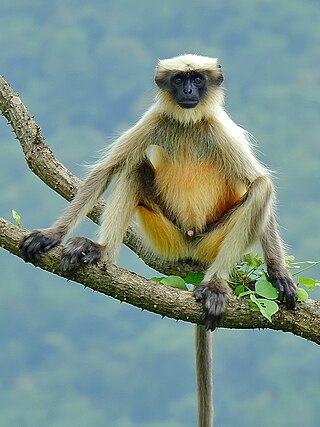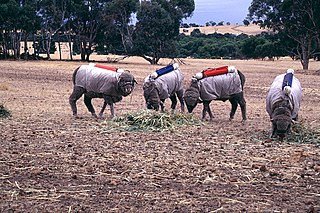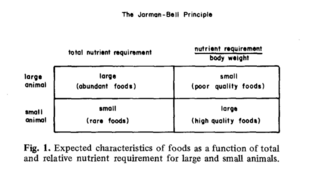Related Research Articles

Coprophagia or coprophagy is the consumption of feces. The word is derived from the Ancient Greek κόπρος kópros "feces" and φαγεῖν phageîn "to eat". Coprophagy refers to many kinds of feces-eating, including eating feces of other species (heterospecifics), of other individuals (allocoprophagy), or one's own (autocoprophagy) – those once deposited or taken directly from the anus.

The stomach is a muscular, hollow organ in the gastrointestinal tract of humans and many other animals, including several invertebrates. The stomach has a dilated structure and functions as a vital organ in the digestive system. The stomach is involved in the gastric phase of digestion, following chewing. It performs a chemical breakdown by means of enzymes and hydrochloric acid.

The large intestine, also known as the large bowel, is the last part of the gastrointestinal tract and of the digestive system in tetrapods. Water is absorbed here and the remaining waste material is stored in the rectum as feces before being removed by defecation. The colon is the longest portion of the large intestine, and the terms are often used interchangeably but most sources define the large intestine as the combination of the cecum, colon, rectum, and anal canal. Some other sources exclude the anal canal.

Dietary fiber or roughage is the portion of plant-derived food that cannot be completely broken down by human digestive enzymes. Dietary fibers are diverse in chemical composition, and can be grouped generally by their solubility, viscosity, and fermentability, which affect how fibers are processed in the body. Dietary fiber has two main components: soluble fiber and insoluble fiber, which are components of plant-based foods, such as legumes, whole grains and cereals, vegetables, fruits, and nuts or seeds. A diet high in regular fiber consumption is generally associated with supporting health and lowering the risk of several diseases. Dietary fiber consists of non-starch polysaccharides and other plant components such as cellulose, resistant starch, resistant dextrins, inulin, lignins, chitins, pectins, beta-glucans, and oligosaccharides.

The gastrointestinal tract is the tract or passageway of the digestive system that leads from the mouth to the anus. The GI tract contains all the major organs of the digestive system, in humans and other animals, including the esophagus, stomach, and intestines. Food taken in through the mouth is digested to extract nutrients and absorb energy, and the waste expelled at the anus as faeces. Gastrointestinal is an adjective meaning of or pertaining to the stomach and intestines.

The cecum or caecum is a pouch within the peritoneum that is considered to be the beginning of the large intestine. It is typically located on the right side of the body. The word cecum stems from the Latin caecus meaning blind.

The appendix is a finger-like, blind-ended tube connected to the cecum, from which it develops in the embryo. The cecum is a pouch-like structure of the large intestine, located at the junction of the small and the large intestines. The term "vermiform" comes from Latin and means "worm-shaped". The appendix was once considered a vestigial organ, but this view has changed since the early 2000s. Research suggests that the appendix may serve an important purpose as a reservoir for beneficial gut bacteria.

Digestion is the breakdown of large insoluble food compounds into small water-soluble components so that they can be absorbed into the blood plasma. In certain organisms, these smaller substances are absorbed through the small intestine into the blood stream. Digestion is a form of catabolism that is often divided into two processes based on how food is broken down: mechanical and chemical digestion. The term mechanical digestion refers to the physical breakdown of large pieces of food into smaller pieces which can subsequently be accessed by digestive enzymes. Mechanical digestion takes place in the mouth through mastication and in the small intestine through segmentation contractions. In chemical digestion, enzymes break down food into the small compounds that the body can use.

Ruminants are herbivorous grazing or browsing artiodactyls belonging to the suborder Ruminantia that are able to acquire nutrients from plant-based food by fermenting it in a specialized stomach prior to digestion, principally through microbial actions. The process, which takes place in the front part of the digestive system and therefore is called foregut fermentation, typically requires the fermented ingesta to be regurgitated and chewed again. The process of rechewing the cud to further break down plant matter and stimulate digestion is called rumination. The word "ruminant" comes from the Latin ruminare, which means "to chew over again".
Cud is a portion of food that returns from a ruminant's stomach to the mouth to be chewed for the second time. More precisely, it is a bolus of semi-degraded food regurgitated from the reticulorumen of a ruminant. Cud is produced during the physical digestive process of rumination.
A monogastric organism has a simple single-chambered stomach. Examples of monogastric herbivores are horses and rabbits. Examples of monogastric omnivores include humans, pigs, hamsters and rats. Furthermore, there are monogastric carnivores such as cats. A monogastric organism is comparable to ruminant organisms, such as cattle, goats, or sheep. Herbivores with monogastric digestion can digest cellulose in their diets by way of symbiotic gut bacteria. However, their ability to extract energy from cellulose digestion is less efficient than in ruminants.

The Colobinae or leaf-eating monkeys are a subfamily of the Old World monkey family that includes 61 species in 11 genera, including the black-and-white colobus, the large-nosed proboscis monkey, and the gray langurs. Some classifications split the colobine monkeys into two tribes, while others split them into three groups. Both classifications put the three African genera Colobus, Piliocolobus, and Procolobus in one group; these genera are distinct in that they have stub thumbs. The various Asian genera are placed into another one or two groups. Analysis of mtDNA confirms the Asian species form two distinct groups, one of langurs and the other of the "odd-nosed" species, but are inconsistent as to the relationships of the gray langurs; some studies suggest that the gray langurs are not closely related to either of these groups, while others place them firmly within the langur group.
The rumen, also known as a paunch, is the largest stomach compartment in ruminants and the larger part of the reticulorumen, which is the first chamber in the alimentary canal of ruminant animals. The rumen's microbial favoring environment allows it to serve as the primary site for microbial fermentation of ingested feed. The smaller part of the reticulorumen is the reticulum, which is fully continuous with the rumen, but differs from it with regard to the texture of its lining.

Enteric fermentation is a digestive process by which carbohydrates are broken down by microorganisms into simple molecules for absorption into the bloodstream of an animal. Because of human agricultural reliance in many parts of the world on animals which digest by enteric fermentation, it is the second largest anthropogenic factor for the increase in methane emissions directly after fossil fuel use.
Cecotropes are a nutrient filled package created in the gastointestinal (GI) tract, expelled and eaten by rabbits to get more nutrition out of their food. The first time through the GI tract, small particles of fiber are moved into the cecum, where microbes ferment them. This creates useable nutrients which are stored and expelled in cecotropes. The cecotropes are eaten & the nutrients are absorbed in the small intestine.

The Strongylida suborder includes many of the important nematodes found in the gastrointestinal tracts of ruminants, horses, and swine, as well as the lungworms of ruminants and the hookworms of dogs and cats.

Equine nutrition is the feeding of horses, ponies, mules, donkeys, and other equines. Correct and balanced nutrition is a critical component of proper horse care.
Pseudoruminant is a classification of animals based on their digestive tract differing from the ruminants. Hippopotami and camels are ungulate mammals with a three-chambered stomach while equids and rhinoceroses are monogastric herbivores.
Foregut fermentation is a form of digestion that occurs in the foregut of some animals. It has evolved independently in several groups of mammals, and also in the hoatzin, a species of bird.

The Jarman–Bell principle is a concept in ecology that the food quality of a herbivore's intake decreases as the size of the herbivore increases, but the amount of such food increases to counteract the low quality foods. It operates by observing the allometric properties of herbivores. The principle was coined by P.J Jarman (1968.) and R.H.V Bell (1971).
References
- 1 2 3 Animal Structure & Function Archived 2012-05-02 at the Wayback Machine . Sci.waikato.ac.nz. Retrieved on 2011-11-27.
- 1 2 Grant, Kerrin Adaptations in Herbivore Nutrition, July 30, 2010. Lafebervet.com. Retrieved on 2017-10-16.
- ↑ Hindgut versus Foregut Fermenters. Vcebiology.edublogs.org (2011-04-30). Retrieved on 2011-11-27.
- ↑ Grajal, A.; Strahl, S. D.; Parra, R.; Dominguez, M. G.; Neher, A. (1989). "Foregut fermentation in the Hoatzin, a Neotropical leaf-eating bird". Science. 245 (4923): 1236–1238. Bibcode:1989Sci...245.1236G. doi:10.1126/science.245.4923.1236. PMID 17747887. S2CID 21455374..
- ↑ Lu, Hsiao-Pei; Yu-bin Wang; Shiao-Wei Huang; Chung-Yen Lin; Martin Wu; Chih-hao Hsieh; Hon-Tsen Yu (10 September 2012). "Metagenomic analysis reveals a functional signature for biomass degradation by cecal microbiota in the leaf-eating flying squirrel (Petaurista alborufus lena)". BMC Genomics. 1. 13 (1): 466. doi: 10.1186/1471-2164-13-466 . PMC 3527328 . PMID 22963241.
- 1 2 James (14 May 2010). "Comparative Digestion". VetSci. Retrieved 3 May 2013.
- ↑ Hirakawa, Hirofumi (2001). "Coprophagy in Leporids and Other Mammalian Herbivores". Mammal Review. 31 (1): 61–80. doi:10.1046/j.1365-2907.2001.00079.x.
- ↑ Chilcott, M. J.; Hume, I. D. (1985). "Coprophagy and selective retention of fluid digesta: their role in the nutrition of the common ringtail possum, Pseudocheirus peregrinus". Australian Journal of Zoology. 33 (1): 1–15. doi:10.1071/ZO9850001.
- ↑ Budiansky, Stephen (1997). The Nature of Horses . Free Press. ISBN 0-684-82768-9.
- ↑ van der Made, Jan; Grube, René (2010). "The rhinoceroses from Neumark-Nord and their nutrition". In Meller, Harald (ed.). Elefantenreich – Eine Fossilwelt in Europa (PDF) (in German and English). Halle/Saale. pp. 382–394, see p. 387.
- ↑ Clauss, M.; Frey, R.; Kiefer, B.; Lechner-Doll, M.; Loehlein, W.; Polster, C.; Roessner, G. E.; Streich, W. J. (2003-04-24). "The maximum attainable body size of herbivorous mammals: morphophysiological constraints on foregut, and adaptations of hindgut fermenters" (PDF). Oecologia . 136 (1): 14–27. Bibcode:2003Oecol.136...14C. doi:10.1007/s00442-003-1254-z. PMID 12712314. S2CID 206989975.
- ↑ Evans, A. R.; et al. (2012-01-30). "The maximum rate of mammal evolution". PNAS . 109 (11): 4187–4190. Bibcode:2012PNAS..109.4187E. doi: 10.1073/pnas.1120774109 . PMC 3306709 . PMID 22308461.
- ↑ Williams, Carey A. (April 2004), "The Basics of Equine Nutrition", FS 038, vol. The Equine Science Center, Rutgers University, archived from the original on 2007-04-08, retrieved 2017-04-02
- ↑ Moore, B. E.; Dehority, B. A. (1993). "Effects of diet and hindgut defaunation on diet digestibility and microbial concentrations in the cecum and colon of the horse". Journal of Animal Science. 71 (12): 3350–3358. doi:10.2527/1993.71123350x. PMID 8294287.
- ↑ Brune, A.; Dietrich, C. (2015). "The Gut Microbiota of Termites: Digesting the Diversity in the Light of Ecology and Evolution". Annual Review of Microbiology. 69: 145–166. doi: 10.1146/annurev-micro-092412-155715 . PMID 26195303.
- ↑ Mikaelyan, A.; Strassert, J.; Tokuda, G.; Brune, A. (2014). "The fibre-associated cellulolytic bacterial community in the hindgut of wood-feeding higher termites (Nasutitermes spp.)". Environmental Microbiology. 16 (9): 2711–2722. doi:10.1111/1462-2920.12425.